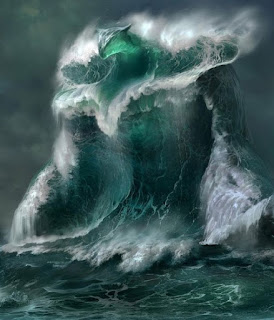 |
| Fire Snakes |
Annbild Hrolmir, or Annbild's Entrail is a great lava river that courses across several regions of
Brucrumus's Underdark. It was named after a legendary captain of the guard that served
Surtur in the
Dawn War. Surtur honored the death of this hero by naming one of the
Great Vein's rivulets after him.
Annbild Hrolmir is a great river of lava that though immense in length is but an artery of the Great Vein of Surtur. The Annbild Hrolmir artery begins in the deepest reaches of the Underdark. Starting from the Great Vein, it pushes straight up for many leagues and then levels off becoming a eastward flowing magma river. When pressure is great enough from below, it causes eruptions at various points along the river. These areas have choke-points where the lava backs up until it can feed through submerged passages. In these areas is always an active volcano, while in areas of a dead volcano the checkpoint is gone from past eruptions, earthquakes or even the doings of something else.
The river begins in
Sygning and flows eastward. Its first pressure release is the volcano
Traeulf. After this volcano the lava river continues east for another four hundred miles where it splits off into two. It goes southeast into Ufthag and continues eastward across the bottom of Garathral. The split lava rivers feed all the volcanic activity of
Agulbandal, and its four active volcanoes - Vaermund,
Kradlod, Vistlod, and Trylming. Leaving Garathral, the lava river continues east, releasing gas and smoke up the
Annbild Pipe and then cutting south where it feeds the lava tubes of Bolmod. In Yol Skerah, a region beneath the Aerie of Dragons, the lava river splits into three with each river ending at a volcano.
Annbild Hrolmir can be travelled by lava barge. It is not a normal route for most though because few can handle the often noxious and poisonous conditions, and extreme heat. The people of
Surticon are the river's major traffickers. They use it move goods to distant ports from Sygning to
Yol Skerah. Travel along the lava flow is stopped in areas where the lava completely fills the tubes. In these areas, a land journey is undertaken to move to the next open area where more lava barges are staged. Beyond the environmental hazard of the river, there are also bands of salamanders, fire snakes, and other fiery brutes.
The lava barges of Annbild Hrolmir, with their crews of fire giants, are the best protection against a hungry fire snake or salamander wielding a man-catcher.
- Phoslomor, cartographer of the Third Epoch, excerpt from the book "Phoslomor's Survey of Midrêth, Ch. 6-2"


















